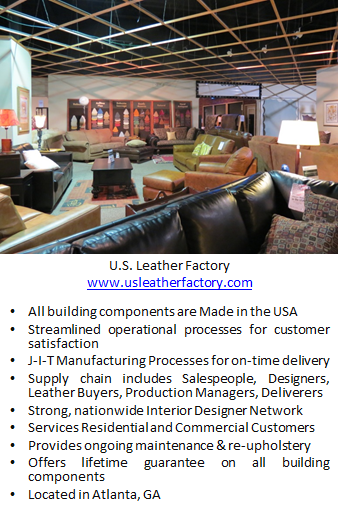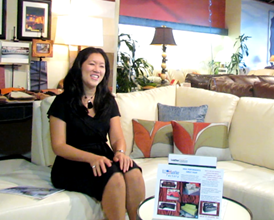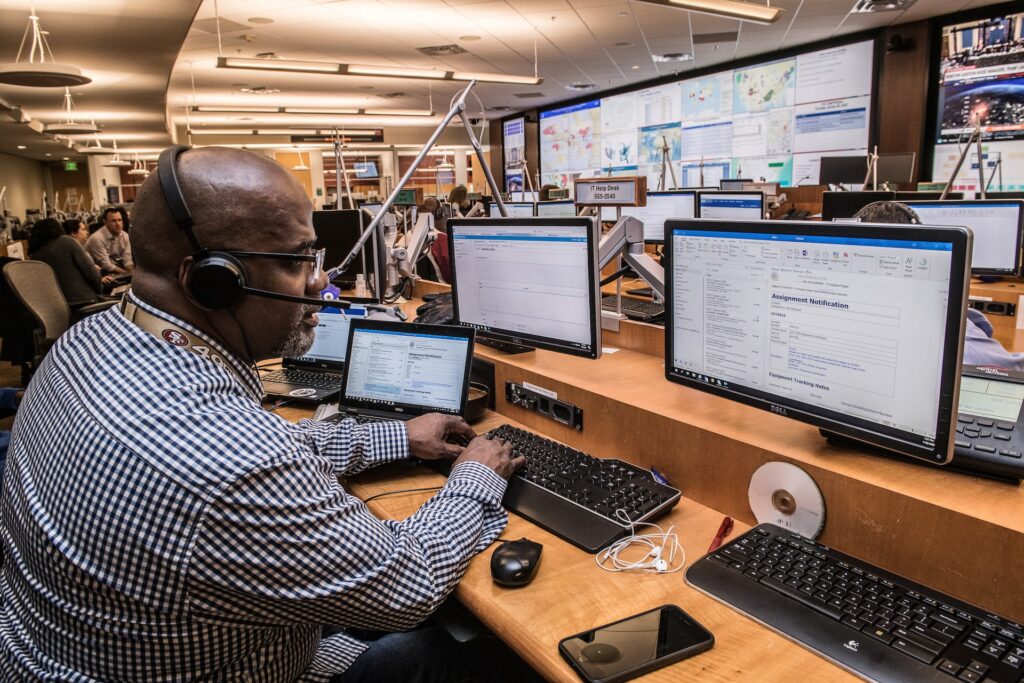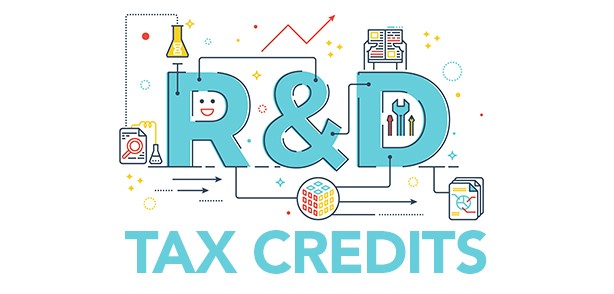Introduction
U.S. Leather Factory (USLF) is a 3.5 year old Atlanta, GA based company that specializes in designing and manufacturing custom leather furniture. USLF is an offshoot (or sister company) of Leather Creations and was primarily created in response to the U.S. economy’s flux following the banking debacle of 2008. The comparative difference lies in USLF’s ability to provide fabric and bonded furniture coverings in addition to pure, 100% leather.
 My personal experience with USLF began earlier this year when I was in search of a leather sleeper sofa. I had a very good idea of what I wanted, but became increasingly frustrated as I visited several furniture stores none of whom had a product that was exactly what I envisioned. When I did find a sofa that bore a close resemblance, my enthusiasm waned once I learned I would have to wait a minimum of 12 weeks for delivery – all because I wanted to change the color of the leather from that displayed in the showroom.
My personal experience with USLF began earlier this year when I was in search of a leather sleeper sofa. I had a very good idea of what I wanted, but became increasingly frustrated as I visited several furniture stores none of whom had a product that was exactly what I envisioned. When I did find a sofa that bore a close resemblance, my enthusiasm waned once I learned I would have to wait a minimum of 12 weeks for delivery – all because I wanted to change the color of the leather from that displayed in the showroom.
By chance, I stumbled upon USLF as I was en route to visit another store in the same shopping center. My husband and I were greeted enthusiastically by Jenny DeLara. Within minutes Jenny was able to draw a sketch based on what we described to her and helped us choose the proper leather, nail heads, feet, arms and other trimmings. Seven weeks later I had the sofa I dreamed of! I was so impressed by USLF and their streamlined operations that I had to share my experience with others.
Jenny DeLara and I recently chatted about the reasons for USLF’s success from an operations management and process improvement perspective. The following points summarize our discussion…
Custom Furniture Benefits – Good Things Come to Those Who Wait
USLF can safely boast its ability to make practically any type of furniture you are looking for that requires a leather covering. Aside from finding the perfect leather or fabric covering, knowing that you can get the exact style of furniture you are looking for (without compromising) is icing on the cake especially if you need furniture for an awkward-sized space. Unlike most traditional furniture stores with showrooms, USLF guarantees its customers a lifetime warranty on the supportive frame structure and ensures that all leather, if properly cared for, will last for at least 20 years.
In fact, on their website, USLF states 9 reasons why their craftsmanship is better. Their furniture has:
1) Larger panels with fewer seams,
2) Removable seats,
3) Matrix suspension,
4) Silent seating,
5) Adjustable suspension,
6) Distributed weight design,
7) Slip sheet padding,
8) ¾” hardwood frames, and
9) Modular frames.
J-I-T Process as a Competitive Advantage
Finding a company that actually produces its goods in the U.S. is becoming increasingly difficult. USLF makes all building components for each piece of furniture in their Atlanta, GA factory. And they have an extensive global network that allows them to offer exotic leather coverings based on customer preferences. Unlike traditional furniture companies, USLF utilizes a Just-In-Time manufacturing approach in their supply chain. This means they only produce furniture when an order is placed and a deposit is collected. Not only does this minimize waste and sitting inventory, but it also streamlines the total production time. In contrast, a traditional furniture store (particularly a chain retail store) orders several units of one type of furniture and at the most can offer its customers a limited selection of different furniture coverings. Look at the figure below that illustrates the difference between the two supply chain models.
In the Spoke and Wheel model, any deviation or change request to a piece of furniture requires a much longer delivery time to the customer as various locations/showrooms must usually send such “custom” requests to one factory that might be centrally located amongst the locations. Here, customization requests are placed in the order received with no preference to customer location.
In the J-I-T model, companies like USLF are not burdened with excessive overhead costs as their traditional furniture store counterparts. Their supply chain requires very little in-stock inventory and fewer salespeople. Orders are received from one location and, in assembly-line fashion, passed forward to its dedicated production facility located nearby. It’s no wonder that a custom order with USLF can take less time than a change request at a traditional furniture store.
The beauty of USLF’s J-I-T model also lies in their careful balance of standardization vs. true customization. Like Harley Davidson, USLF has certain structural frames (standardization) that customers can choose from. Should a customer choose one of those frames, USLF can accurately give an onsite estimate and from there it is simply a matter of the customer selecting how to customize the covering and trimming details. If, however, a customer asked for a type of frame that USLF does not currently have a template for (true customization), then the order and production time can be longer as the design team must work with the production team to ensure such a piece can be made.
Knowledge as an Asset

Photo provided courtesy of Equilibria, Inc.
As a customer of USLF you will come across sage-like subject matter experts at every stage of the process, from the salesperson to the furniture deliverer. This is the rule, not the exception at USLF and according to Jenny DeLara, a USLF Showroom Manager who has a degree in Interior Design, “Customers want more than a salesman. They want someone who can deal with the whole scope because furniture is a big, primary investment. Listening is also very important because if a customer mentions, ‘I have kids and a dog,’ then you know what type of furniture and leather to recommend.” Such knowledge allows someone like Jenny to tailor the furniture’s design and leather selection to the customer’s true needs as opposed to solely making a commission-based recommendation. Click here to learn more about the leather making process.
Standard Operating Procedures as a Training Tool
Streamlined production processes are just half of USLF’s equation in meeting estimated delivery times and ensuring customer satisfaction. The other half includes detailed Standard Operating Procedures (SOPs) which are catalogued as proprietary information and stored in an Operations Manual.
The purpose of USLF’s SOPs is two-fold: 1) to serve as a training tool for new hires and 2) to replicate their proven system in future locations. Their SOPs include everything from learning about their different types of products to properly greeting the customer and learning how to ask the right questions in order to help the customer convey exactly what s/he is looking for.
Their Operations Manual also includes instructions for using their specialty software for inputting orders and providing the customer with a realistic estimate and delivery timeframe. The end result is a seamless supply chain supported by processes that inform the customer of each step, build report and establish trust. No process is complete without troubleshooting procedures and as such, USLF has an internal process that requires constant communication with customers should any production bottlenecks occur. Production bottlenecks can include natural disasters and changes to shipping regulations.
4 Steps for Applying USLF’s Model to Your Business
Hopefully you’ve learned something new or received some type of revelation for improving your own company’s operations. Internal processes are just as important as external processes and both work together to create remarkable staff and client experiences. Think about those businesses you’ve patronized recently. Which were you impressed by and why? How about those that disappointed you in some way? Can the difference be attributed to their processes or lack thereof?
What kind of customer experience is your business creating?
Using the KasennuTM operations management and business infrastructure methodology, you can retrofit USLF’s operational success by following these four steps:
- Figure out what needs to be done and who should do it. I call this the Business Parts Analysis and it helps in making sure you attract and retain top notch talent to represent your company.
- Develop a communication chain of command to make sure important tasks don’t fall through the cracks. Through a Business Design Blueprint, customer issues can be mitigated quickly before escalating unnecessarily.
- Measure the amount of time it takes to provide your company’s final deliverable to its customer, whether it is a product or service. Segment the time into stages and figure out how to incorporate technology and personnel to streamline the time for future replication. This will become your company’s Service Delivery Blueprint.
- Group all tasks that must be performed into processes. Document each process and write according to the purpose (i.e. training tool, software development). Gather all processes and store in a Business Process Manual.











